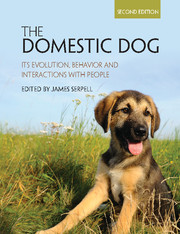Book contents
- Frontmatter
- Dedication
- Contents
- List of contributors
- 1 Introduction
- PART I ORIGINS AND EVOLUTION
- PART II BEHAVIOR, COGNITION AND TRAINING
- PART III DOG-HUMAN INTERACTIONS
- 13 Dogs as helping partners and companions for humans
- 14 The welfare of dogs in human care
- 15 From paragon to pariah: Cross-cultural perspectives on attitudes to dogs
- PART IV LIFE ON THE MARGINS
- Index
- Plate section
- References
13 - Dogs as helping partners and companions for humans
from PART III - DOG-HUMAN INTERACTIONS
Published online by Cambridge University Press: 30 December 2016
- Frontmatter
- Dedication
- Contents
- List of contributors
- 1 Introduction
- PART I ORIGINS AND EVOLUTION
- PART II BEHAVIOR, COGNITION AND TRAINING
- PART III DOG-HUMAN INTERACTIONS
- 13 Dogs as helping partners and companions for humans
- 14 The welfare of dogs in human care
- 15 From paragon to pariah: Cross-cultural perspectives on attitudes to dogs
- PART IV LIFE ON THE MARGINS
- Index
- Plate section
- References
Summary
Introduction
Currently in the United States, about 78 million dogs reside in households (American Pet Products Association (APPA), 2011; American Veterinary Medical Association (AVMA), 2012). Relationships between humans and dogs continue to change, with pet dogs often referred to as companions and family members, and a growing number serving in assisting or supportive roles. Reflecting the changing status of dogs, sometimes terms such as “caregivers,” “guardians” or “handlers” are used rather than “owners.” Dogs are everywhere people live and play, providing partnership in all aspects of human life, including hunting, herding, sledding, guarding, military activities, law enforcement, assisting, and for therapeutic purposes. The dog is the only domestic species that plays such diverse roles for humans, as companions and increasingly as working partners (Hart et al., 2000; Kuhl, 2008; Lane et al., 1998). People go walking, hiking, running, and even camping with their dogs. Some enjoy sport competitions for dogs, such as agility contests, frisbee, and dog-dancing (Kobelt et al., 2003). TV advertisements include dogs in the scenes with families. Dog walking for improved public health is a topic of focused research interest (Ham & Epping, 2006), and many studies report beneficial physiological, psychological and social effects of dogs for humans (Hart, 2010). Training “service dogs” for working tasks to assist and aid people with disabilities is a growing enterprise in the US. The legal framework regarding public access for people with disabilities and their service dogs rapidly evolves. In the US, dogs (and other species) with no special training are even accorded special legal status in regards to housing and transportation as “emotional support animals” (ESAs). This chapter emphasizes the rapid changes currently occurring with dogs’ status in their assistive, supportive, and therapeutic roles for people with disabilities.
Dogs as a special species
Comparisons with other species
Among companion animals, dogs are exceptional. Over a century ago, a large survey of children's school essays about pet animals had already demonstrated the dog's outstanding popularity (Bucke, 1903). These children emphasized the highly personalized attention provided by their dogs with phrases such as “he likes me,” “guards me,” “follows me,” “protects me,” “barks when I come home from school,” and “is good to me.” The children appreciated the dog's ability to express love and affection by jumping up, running around, wagging its tail and soliciting play.
- Type
- Chapter
- Information
- The Domestic DogIts Evolution, Behavior and Interactions with People, pp. 247 - 270Publisher: Cambridge University PressPrint publication year: 2016
References
- 8
- Cited by

